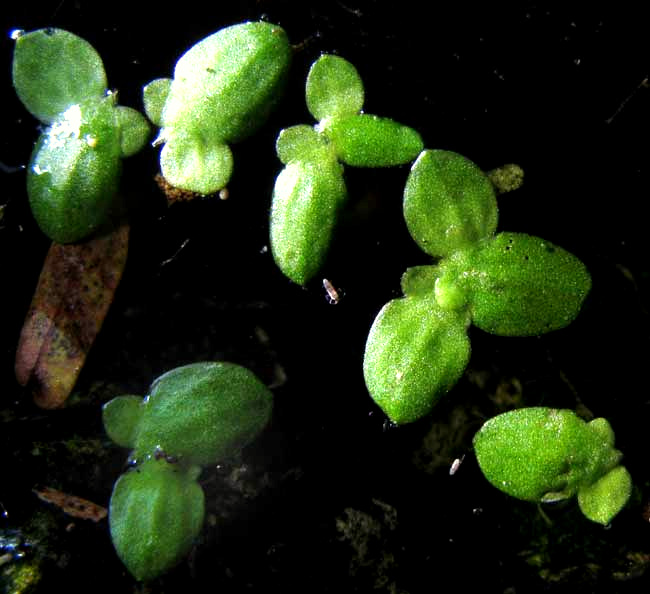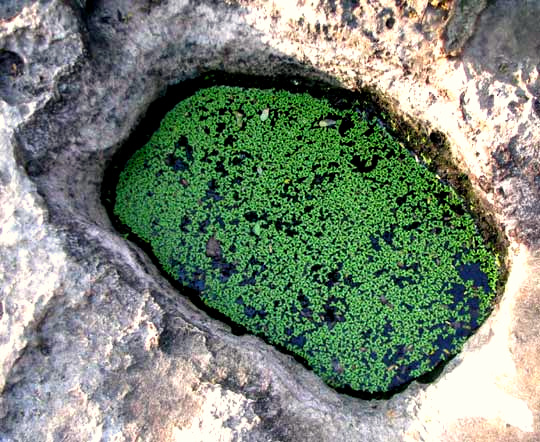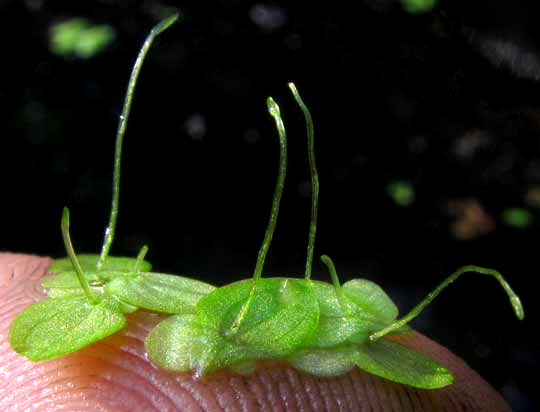Excerpts from Jim Conrad's
Naturalist Newsletter

from the March 6, 2011 Newsletter issued from Hacienda Chichen Resort beside Chichén Itzá Ruins, central Yucatán, MÉXICO; limestone bedrock, elevation ~39m (~128ft), ~N20.676°, ~W88.569°
DUCKWEED IN A HALTÚN
Haltunes (singular haltún), are special features of this area's landscape, which is developed upon limestone and referred to as exhibiting karst topography. A haltún is merely a smallish depression or hole eroded into the limestone, maybe the size of a small dog or a cow. Haltunes fill with water after rains. Since there are no aboveground rivers or streams in northern and central Yucatán, haltunes are important to wildlife and people needing water. You can see typical haltunes here at Hacienda Chichen at www.backyardnature.net/yucatan/haltun.htm.
Cenotes, or sinkholes with water in their bottoms, are much, much larger than haltunes, resulting from the collapse of limestone ceilings of underground rivers and caverns.
Haltunes hold water for weeks after a good rain. However, during the dry season often weeks pass without a drop of rain, and then most or all our haltunes dry up. Our last rain came about three weeks ago so now most of our haltunes are dry, but some deeper ones still contain rainwater. An especially deep, dog-size one in the Alux Grove holds several inches of black water and is frequented by Black Vultures who drink there, in the process leaving the water enriched by their poop. The surface of that Haltún is now carpeted with green duckweed, as shown below:

A close-up of some duckweed plants in the above haltún is shown at the top of this page.
Floating flush with the water's surface, the flat, oval bodies are known as fronds. The larger ones are about 1/5th inch long (5mm). Each frond is a separate plant and you can see that they grow in clumps. Each clump consists of a larger frond or "mother frond," with smaller ones budding from larger ones. In time the thin, white "stipe" connecting the mother frond with the daughters rots or falls away, at which time the daughters become mothers with their own budding daughters. Duckweeds are flowering plants but the flowers are tiny and not present on fronds in the picture.
If you dip your finger into the water and retrieve some fronds so that they're upside down you see what's seen below:

Each frond sprouts a single root that dangles into the water below, but in the picture sticks into the air. Each frond having a single root instead of several is a field mark differentiating the duckweed genus Lemna from other closely related genera, whose fronds bear more than one root. The three conspicuous veins seen on each frond in the picture help distinguish this Lemna species from a dozen others, some which have only one vein or up to seven.
In the last picture notice that each root tip flares and flattens like a cobra's head. Root tips of most species don't do that -- they just end with a cylindrical, rounded tip. Such flaring, flattened root tips constitute an important field mark helping us identify what we have here as LEMNA AEQUINOCTIALIS, a species typical of warm-temperate to tropical zones worldwide, in the US sporadically occurring as far north as Nebraska and even Wisconsin.
The online Flora of North America assigns duckweeds to their own family, the Lemnaceae. However, other authors have begun lumping the Duckweed Family into the Aroid or Jack-in-The-Pulpit Family, the Araceae. Come to think of it, the Aroid Family also contains aquatic Water-Lettuce, genus Pistia, so duckweeds being included in the Araceae isn't really outrageous.
José the shaman says that in the forest when you find a haltún with duckweed on it, the water in that haltún will have absorbed medicinal qualities from the duckweed, and the water can be used against arthritis.
I don't see much duckweed here. In the North sometimes large areas of stagnate water are completely carpeted with it, as in some of the swamps back in Mississippi where ducks and other such critters eat plenty of it. I've not noticed Lemna aequinoctialis up there, so finding it here is a nice surprise.